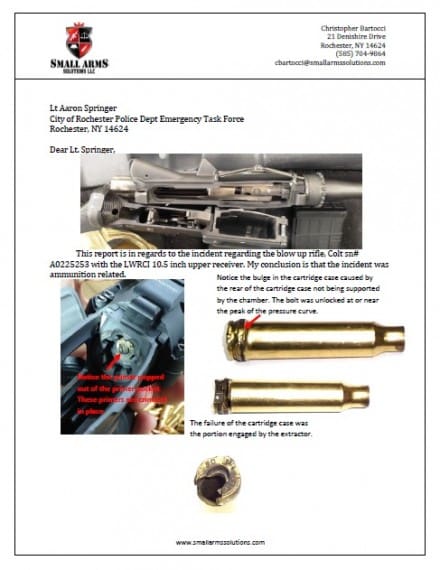
An LEO and reader of ours recently passed along a report of a blown up weapon that was in use within his department. The report, which was made after an analysis by Small Arms Solutions, details an AR-15 with a Colt lower and an LWRC 10.5 inch upper, which seemingly experienced catastrophic failure due to a faulty Federal Ammunition American Eagle cartridge. The full details of the report can be read in the attached .pdf. Additionally, all three companies, Federal, Colt, and LWRC, are working with the department to correct the issue.
Tags: Colt, Federal Ammunition, LWRC, Small Arms Solutions


It must be because he had more than 7 rounds in that magazine…
looks like it is more of a weapon problem than a ammo one. out of battery firing bad headspace? round set back to increase pressure? what mag was used how old? weak lips, springs? my .02 based only on reading the report and looking at the tell tale photos of the other dented mangled cartridges. lots of unanswered questions in that report. In battery detonation of over pressure rounds tends to buldge or blow barrels.?
Read the report again. The overpressure rounds caused the piston to slam into the carrier with greater force, causing the bolt to unlock early before the chamber pressure was safe. This caused premature extraction of case and allowed the unsupported part of the case to rupture.
those bent rounds were from other weapons as well, if you read the report
An AR-15 simply can’t fire out of battery. A mechanical safety is a design feature of the bolt group that prevents this from happening.
Why would anyone put a high end LWRC upper with a crap ass Colt lower
OLD Department Issued FFL lower. High quality NEW upper..
Perhaps you missed the autosear? That’s not just any old AR15 lower: it’s an M16 lower.
Wow you must not know anything about AR pattern rifles.
I wonder what weight buffer he was using. Piston ARs tend to have a faster bolt carrier velocity than DI, so that combined with overpressure ammo likely caused all those failures to feed. If he had been using a properly weighted buffer the carrier could have been slowed enough to at least allow the magazine to keep up. Still wouldn’t have prevented that nasty case failure though…
I’m the layperson in this one, but why did they continue to fire that rifle or those batches of ammo after THAT many malfunctions, with what looked to be more than one M4 in play? Everyone on the line should have been hollering for a stop-and-assess with the first or perhaps 2nd round failure-to-feed or eject. Doesn’t say if anyone was injured, but they could have been, but for the good graces of God almighty.
None of the author’s “assumptions” are supported by any appreciable “root cause analysis” and are based entirely on speculation. I see no mention of a tech tear down of the ammo to support his “Hot load” theory. This pulp formatted in the manner of a “Safety Of Use Message” is irresponsible on the part of Mr. Bartocci and I would question his motivation for such premature publication that apparently indemnifies LWRC’s upper.
A more pragmatic approach would be to:
1. Examine the ammunition in question to determine if the powder loads, case dimensions, ogive seating depth, etc. were compliant with the manufacture’s specifications.
2. A complete technical inspection of the upper and lower to determine if there were any manufacturing defects, incorrect or worn assemblies that may have attributed to the failure.
3. Examination of the magazines used
As someone else stated, why with so many apparent failures and malfunctions did the individual keep firing the weapon? In my opinion, Mr. Bartocci should officially redact this until a more pragmatic and professional “root cause analysis” into the failure is conducted. Preferably by a third party who is not biased.
I did not publish this for general review, but specifically for the lieutenant to it is addressed. And I have knowledge who released this. There are many details that are not in this report, due to the fact it went to the officers involved. The ammunition is in the process of being evaluated by Federal. They have recalled the entire lot. This is only the preliminary part of the investigation and is far from over. There was a full examination of the rifle, which included: head space, bore straightness, as well as chamber condition. Also, the cartridges that were malfunctioning were not from a single rifle but from several that were malfunctioning down the entire line. Unfortunately, this report was released and now I’m subject to “peanut gallery” analysis of my findings. I can assure you I’m impartial and well qualified to submit my findings and that is why I have worked for so long in the industry. And specifically I’ve serviced this police departments weapons for the last 10 years free of charge because I’ve always been committed to keeping our service men and women safe. Hopefully I’ve answered some if your questions. A final report will not be written until the conclusion of the ammo analysis.
Soooo…. Federal recalled the whole lot eh? Can you please point me to said “recall notice”?
Does the Rochester PD enforce the SAFE act?
An incipient case head separation/failure caused the carbine in question to go high order. The head structure of the cartridge case was compromised when it was formed and it failed when the cartridge was fired. It’s really that simple. A Google search will reveal countless examples of the phenomenon. There is no need to pursue an exhaustive analysis of this event for a number of reasons. I have to agree that many of the authors conclusions are speculative and at least one is flat wrong.
I can easily see shooters working through malfunctions instead of immediately quitting the gun, until it becomes apparent that something extra-weird is going on.